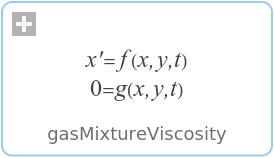WOLFRAM SYSTEM MODELER
gasMixtureViscosityReturn viscosities of gas mixtures at low pressures (Wilke method) |
|
Wolfram Language

SystemModel["Modelica.Media.IdealGases.Common.MixtureGasNasa.gasMixtureViscosity"]

Information
This information is part of the Modelica Standard Library maintained by the Modelica Association.
Simplification of the kinetic theory (Chapman and Enskog theory)
approach neglecting the second-order effects.
This equation has been extensively tested (Amdur and Mason, 1958;
Bromley and Wilke, 1951; Cheung, 1958; Dahler, 1959; Gandhi and Saxena,
1964; Ranz and Brodowsky, 1962; Saxena and Gambhir, 1963a; Strunk, et
al., 1964; Vanderslice, et al. 1962; Wright and Gray, 1962). In most
cases, only nonpolar mixtures were compared, and very good results
obtained. For some systems containing hydrogen as one component, less
satisfactory agreement was noted. Wilke's method predicted mixture
viscosities that were larger than experimental for the H2-N2 system,
but for H2-NH3, it underestimated the viscosities.
Gururaja, et al. (1967) found that this method also overpredicted in
the H2-O2 case but was quite accurate for the H2-CO2 system.
Wilke's approximation has proved reliable even for polar-polar gas
mixtures of aliphatic alcohols (Reid and Belenyessy, 1960). The
principal reservation appears to lie in those cases where Mi>>Mj
and etai>>etaj.
Syntax
Inputs (3)
| yi |
Type: MoleFraction[:] (mol/mol) Description: Mole fractions |
|---|---|
| M |
Type: MolarMass[size(yi, 1)] (kg/mol) Description: Mole masses |
| eta |
Type: DynamicViscosity[size(yi, 1)] (Pa⋅s) Description: Pure component viscosities |
Outputs (1)
| etam |
Type: DynamicViscosity (Pa⋅s) Description: Viscosity of the mixture |
|---|
